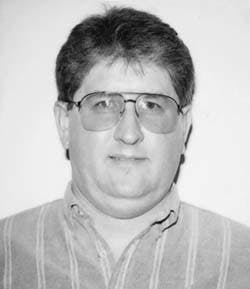TECHNOLOGY New process removes inorganic chlorides from reformate
Ed Alverson, Andrew J. Mullenix
Petrolite Corp.
Houston
A new process for continuous removal of inorganic chloride from reformate in catalytic reformers has proven effective in pilot plant testing.
The process consists of washing unstabilized reformate with an aqueous phase to remove chloride compounds, then separating the aqueous phase using patented distillate-treating technology. Field pilot tests have demonstrated removals of down to 0.024 ppm(wt) Cl-.
Problems revealed
Continuous catalyst-regeneration reformers represent the peak of reforming technology. Of all reforming processes, these units come closest to providing a continuous, constant-quality process for the production of a reformate stream with consistent octane. The technology, however, is not without inherent problems.
Chloride deposition and corrosion problems in equipment downstream of continuous-regeneration reformers have been reported in some 30% of all such units. Based on the authors' discussions with unit operators, it is believed that actual occurrences may be more than 90%.
These problems have manifested in reactor effluent exchangers, coolers, and stabilizers. Typically, corrosion is reported on stabilizer trays.
Deposition in recycle and net hydrogen compressors also has been reported. Deposition and corrosion typically occur repeatedly, and may result in unscheduled downtime or processing interruptions of 2 or 3 days for tower washing, or as long as 4 weeks for tray replacement.
Additionally, deposition may accumulate to the point that it causes localized flooding or faulty fractionation, resulting in lost production, downstream reprocessing, or feed-rate reduction. Ultimately, there are reductions in reformate production and fuel blending efficiency.
While these deposition and corrosion problems are most obvious in continous-regeneration reformers, any catalytic reforming or isomerizing unit may exhibit the same problems, with similar results.
Failure without warning
The continuous-regeneration process requires ongoing addition of an organic chloride compound to maintain catalyst activity. This organic chloride reacts in the reforming environment to produce HCl and an alkyl organic compound.
The HCl produced in the reformer reacts with ammonia (if present) to form ammonium chloride
( NH4 Cl), which is insoluble in reformate. The HCl and NH4Cl are carried by the reactor effluent through downstream equipment until the NH4Cl deposits in quiescent zones of the equipment, or is carried out of the unit with the product. The NH4Cl is released in downstream equipment like fractionation towers, depositing on the trays in the feed and rectifying zones.
Unlike general HCl corrosion, NH4Cl deposition often results in localized, underdeposit corrosion, which offers no tangible, early warning signs of its occurrence. In practice, failure is often the first symptom.
Corrosion and deposition buildup take place over a period of 2 months to 3 years, depending on chloride addition rate, turnaround cycles, and other operating conditions. Fouling may become apparent in heat exchangers and distillation tower trays. The fouling results in aberrations in performance (i.e., differential pressure swings, poor fractionation, or both).
These problems, in turn, result in potential lost revenues from improper fractionation, excessive reformer severity, reprocessing, and off-specification products. Operating costs increase because of greater heater duty, material rerun, and additional tankage requirements.
Depending on build-up rate, a plant operator may expect the effects of corrosion to force replacement of as many as 10 trays in a distillation tower over 3 years. Perhaps even more disconcerting is the fact that regular addition of even 1 ppm Cl- or less to the reformer system process can result in sufficient deposition to cause tower upset as often as every 3 months.
Proposed solutions
Predicting underdeposit corrosion is difficult. One can be sure that, if deposition is occurring and moisture is present, there will be some underdeposit corrosion taking place.
The most certain local method of prediction is monitoring the differential pressure across the rectifying section of the stabilizer tower. An increase indicates that deposition is occurring.
Additionally, performing routine chloride balances helps predict the rate of deposition. Tedious sampling and analysis and added manpower costs, however, prevent most refiners from performing such monitoring.
A preferred approach to mitigating chloride deposition and corrosion problems is a preventive measure designed to achieve two objectives:
- Eliminate NH4Cl deposition and corrosion problems, or at least reduce their frequency from 3 years to 10-20 years.
- Reduce operational and replacement costs associated with deposition and shutdown.
Pilot tests have verified that these objectives are achievable through a chloride removal process that consists of washing unstabilized reformate with an aqueous phase to remove all water-soluble chloride compounds, then separating the aqueous phase using patented distillate treating technology.
The process is initiated by injecting either wash water or pH-adjusted wash water into the liquid stabilizer feed upstream of a mixing device designed to contact water and hydrocarbon intimately enough to extract any HCl or NH4Cl present in the reformate. The wash water source can be stripped sour water or any other source suitable for crude desalting.
Once the chloride compounds have been extracted, electrophoretic coalescence is used to separate the aqueous phase from the reformate.
Electrophoretic coalescence is the most powerful separation technique known from removing free water from distillates. Treatment in an electrophoretic field typically removes all free water, reducing water content to near solubility levels.
The chloride compounds leave the treating unit with the wash water. The effluent water can be recycled internally, reused as desalter wash water, or sent to a wastewater treatment facility.
The gasoline component exits the top of the vessel, virtually free of any entrained moisture and, thus, free of any inorganic chloride species.
Currently, this philosophy, which takes advantage of the hydrophilic nature of NH4Cl and HCl, is being applied to distillate treating in other refining operations.
Pilot study
During April and May 1995, a pilot plant study was conducted in a 23,000 b/d continuous-regeneration reformer at a Texas refinery. The test was designed to determine the feasibility and effectiveness of the process for removing reformate chlorides.
The unit had experienced several incidents of unscheduled downtime and tray replacements as a result of chloride deposition and corrosion.
A self-contained, skid-mounted, electrostatic precipitator was provided for the onsite test, which was conducted on a stabilizer-feed slip stream. Operating conditions were varied, and several stream properties were monitored to develop conditions at which chlorides could be effectively removed.
Fig. 1 [85870 bytes] is a schematic of the process, as applied to a reformer.
Pilot unit
The pilot unit's main piece of equipment was an 8 ft x 8-in. diameter Schd 80 steel pipe acting as a vertical separator vessel. The vessel was equipped with an internal electrode, a 5-kv dc power unit, a meter pump, and a mixing system comprising a line-sized static mixer and a globe valve.
The unit was designed to operate over a broad range of conditions, typically:
Test process
The stabilizer feed entered the distillate treating unit under supply pressure. The feed was measured and injected with wash water supplied from a nearby condensate control station. The combined streams were mixed through a static mixer, then flowed into the electrostatic precipitator.
The wash water was coalesced by the electrostatic field and separated. The reformate then flowed out on pressure control back to the product separator. The wash water flowed out on level control under system pressure to a nearby sewer funnel.
Procedure
After the reformate feed rate was established, the electrode voltage and wash water rate were fixed to start the unit. Flows and pressures were adjusted to meet the desired initial test conditions.
The system was allowed to run for 2 hr to stabilize operations. Operating conditions then were varied to define general limits and conditions for chloride removal.
The operating conditions were recorded, and samples of feed and effluent reformate and feed and effluent water were taken. Inlet and outlet reformate samples were analyzed for inorganic chloride content, water content, and specific gravity. Inlet and outlet wash water samples were collected for pH analyses.
Typical observed values are shown in Table 1 [12366 bytes].
Because the treated reformate was returned upstream, there was no opportunity in this pilot test to demonstrate downstream process benefits.
Results
Chloride removal rates of 97% were demonstrated (Table 2 [16556 bytes]).
Based on previous samples, the authors expected that the chlorides would exist primarily as NH4Cl, rather than HCl. Similarly, it was expected that water wash alone would be required to remove the NH4Cl salt, in a straightforward task. It also was expected that removals of greater than 90% should be readily accomplished.
The testing confirmed these expectations. In addition to successful chloride removal, however, several interesting outcomes were observed:
- The pH of the wash water decreased significantly during the program. It was not uncommon for the pH of the inlet wash water (~9.5) to be reduced to 4.0. This tends to confirm the presence of free HCl, which had not been observed before.
- While monitoring reformate water carry-over, it was apparent that there was no visible entrainment. The total water content of the reformate, however, as measured by Karl-Fischer analysis, increased across the distillate treating unit (from about 25 to 250-300 ppm[vol]). The consistency of the outlet water content and the lack of any visible entrainment implies that this water gain was all water of solubility.
- Effective chloride removal was achieved with wash water quantities of 4% or less, because of the superior phase separation of the electrostatic precipitator.
The deposition of NH4Cl in equipment requires the presence of NH4Cl in the reformate. Because of the hydrophilic and oleophobic nature of NH4Cl, it is, for all practical purposes, completely dissolved in the aqueous phase.
Upon phase separation, the only source of NH4Cl is entrained NH4Cl-enriched aqueous phase. With minuscule (䔮 ppm[vol]) entrainment, the NH4Cl can be present only in sub-ppm concentrations. In fact, measured outlet reformate chloride concentrations of ۫ ppm(vol) were routinely observed.
The tests proved that reduction of ammonium chloride salt content in the reformate stream downstream of the product separator can be achieved. This should reduce fouling and underdeposit corrosion in the downstream equipment. Free of this concern, refiners can increase chloride dosages to maintain operating severity.
A reduction in stabilizer tray fouling should promote proper fractionation, resulting in the realization of: improved aromatics and C5 recovery, attainment of relatively constant Rvp specifications, and unloading of downstream product and LPG recovery equipment.
The Authors
Ed Alverson is research and business development manager for the Petreco division of Petrolite Corp. Since earning a BA in chemistry from David Lipscomb University in 1975, he has been involved in research and product development, technical services, and research management, as well as technical product management, and district and regional sales and business development, for the oil production, refining, petrochemical, and equipment industries.
Andrew J. Mullenix is a senior development engineer with the Petreco division of Petrolite Corp., Houston. He is responsible for new technology and applications development and commercialization. He has worked in the refining, equipment, and petrochemical industries since earning a BS in chemical engineering from Lamar University in 1972.
Copyright 1996 Oil & Gas Journal. All Rights Reserved.


